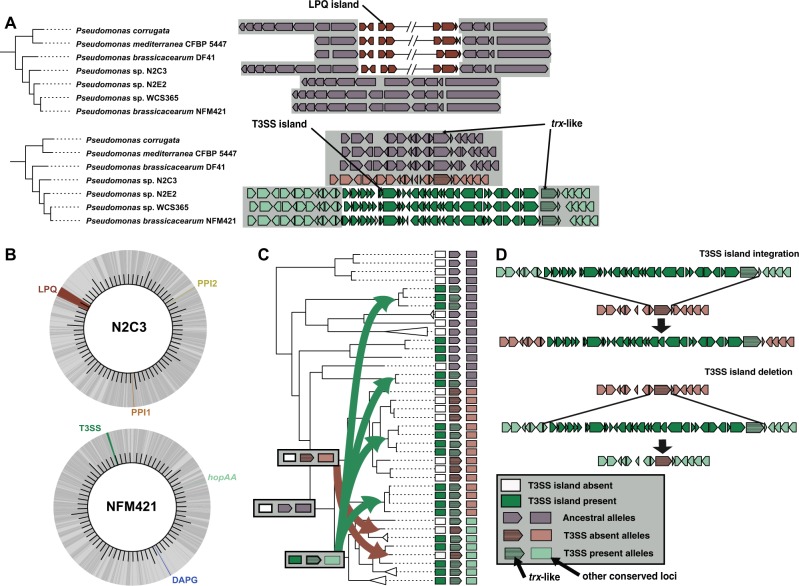Fig. 4.
Phylogenomic evidence for independent island gain and loss through homologous recombination of flanking regions. a Insertion sites for each locus are conserved throughout the bcm species complex. The LPQ and type III secretion system (T3SS) island insertion sites are shown here for the seven bcm clade strains that we characterized experimentally. All insertion sites for all six loci in the 85 strains can be found in Figures S5-S10. The tree shows the evolutionary relationship of the bcm strains. The gray background highlights that the conserved regions flanking both islands are adjacent in strains lacking the island. The location of the trx-like gene is shown adjacent to the T3SS, which is used as a marker for recombination in c. b Circular genome plots of two representative complete genomes from the pathogenic strain N2C3 and the beneficial strain NFM421. Darker gray regions of the genome represent the core genome of the bcm clade, while light gray denotes the variable genome. c A species phylogeny for the bcm clade adapted from Fig. 3 to show evidence of homologous recombination of the T3SS island inferred through phylogenetic incongruencies between the species tree and the phylogeny of the trx-like gene (see Figure S13). Dark green rectangles denote taxa that have the T3SS island, while white rectangles represent taxa missing the island. Based on the phylogenetic evidence, we propose a parsimonious model for evolution of the T3SS island where gain of the T3SS island led to divergence of an ancestral lineage (purple arrow/rectangle) into a lineage with the T3SS present (light green arrow/rectangle) and a lineage with the T3SS absent (light red arrow/rectangle). However, subsequent gain (green arrows) or loss (red arrows) of the T3SS island has led to phylogenetic incongruence between the adjacent trx-like gene and the conserved loci used to construct the species tree (i.e. the bcm clade clonal phylogeny). d A diagram of the proposed homologous recombination mechanism leading to island gain (top) and loss (bottom). Both events lead to insertion of a trx-like allele with a distinct history from the surrounding conserved chromosomal loci

